Thursday, September 23, 2010
Tuesday, June 1, 2010
Saturday, April 3, 2010
So where's Barbie? :D
Tee hee! She is awaiting her very own entry. I will return with what info I can glean, though my warning here is that I'm no expert (I was a Dawn fan myself)!
Monday, March 29, 2010
2001-2010

Peek-A-Boo Petites
The Peek-a-Boos are a kind of cheat because technically they are under the Barbie umbrella; but not really as a brief examination easily reveals the fact that stylistically they have far more in common with Bratz than with Barbie (could it possibly be the same designer? They came out at about the right time)!
These diminutive dolls (about 2 1/2") come in a bewildering array of styles; the one I show here is a necklace. (Yes, they do seem to be attempting the Kiddle ground - but oh they are SO not Kiddles! :( )
I won't so much as attempt an enumeration of the various types here; suffice it to say that there are probably hundreds! They are a great deal like modern Polly Pockets; they have accessories and play-sets galore.
These diminutive dolls (about 2 1/2") come in a bewildering array of styles; the one I show here is a necklace. (Yes, they do seem to be attempting the Kiddle ground - but oh they are SO not Kiddles! :( )
I won't so much as attempt an enumeration of the various types here; suffice it to say that there are probably hundreds! They are a great deal like modern Polly Pockets; they have accessories and play-sets galore.
1991-2000
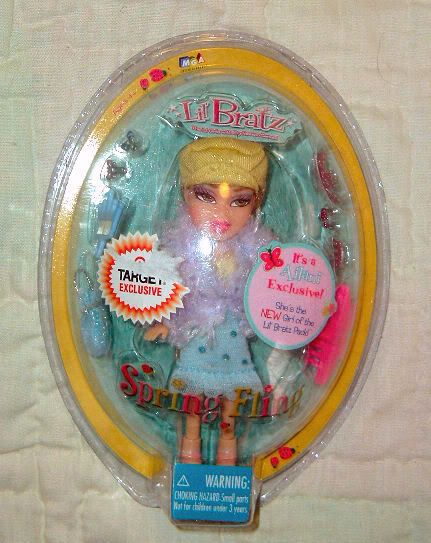
Bratz
These dolls are the first in the blog to be truly in any way controversial. They have very exaggerated heads, with huge lips; they do show a post-pubescent female body, certainly, and the clothes that have been put onto these bodies have stirred up a great deal of controversy.
They are supposed to appeal to the working-class, multi-ethnic market that the rarified world of Barbie has never seemed to properly hit. The clothes have been called "trashy;" so have the dolls.
Apparently the creator was working for the maker of these dolls, MGA Entertainment, and Mattel at the same time. Mattel solved this problem in the approved 21st-century fashion: Within the past 2 or so years, they bought out the original producer and are now the sole proprietors of Bratz.
The dolls have plastic removable feet (you can switch out "shoes" this way), removable fashions and rooted hair. They have a kind of slyly beguiling quality in the case of some that appealed to me enough to get two examples of the 6" size "Li'l Bratz" - they come in 11", 6" & an even smaller size (not certain exactly how large) which size I resisted (I am a "tinies" collector) due to the fact that they have pop-on-off plastic clothing.
They are supposed to appeal to the working-class, multi-ethnic market that the rarified world of Barbie has never seemed to properly hit. The clothes have been called "trashy;" so have the dolls.
Apparently the creator was working for the maker of these dolls, MGA Entertainment, and Mattel at the same time. Mattel solved this problem in the approved 21st-century fashion: Within the past 2 or so years, they bought out the original producer and are now the sole proprietors of Bratz.
The dolls have plastic removable feet (you can switch out "shoes" this way), removable fashions and rooted hair. They have a kind of slyly beguiling quality in the case of some that appealed to me enough to get two examples of the 6" size "Li'l Bratz" - they come in 11", 6" & an even smaller size (not certain exactly how large) which size I resisted (I am a "tinies" collector) due to the fact that they have pop-on-off plastic clothing.
1981-1990
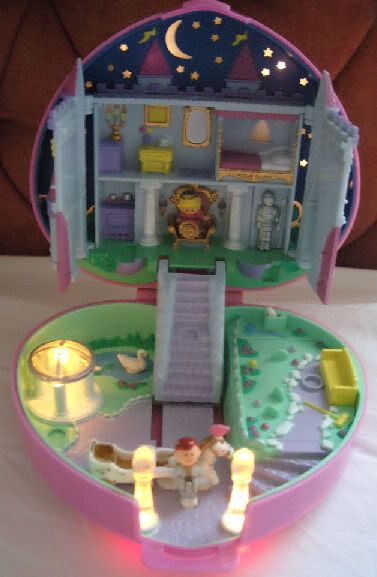
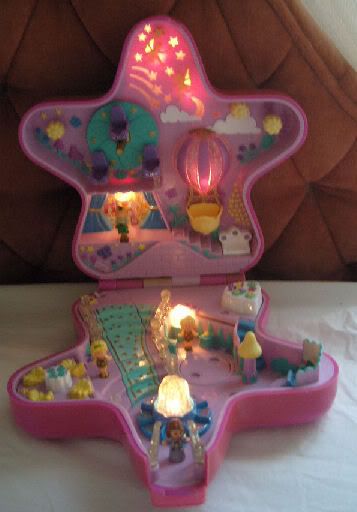
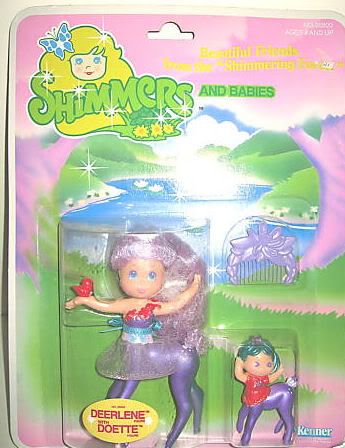
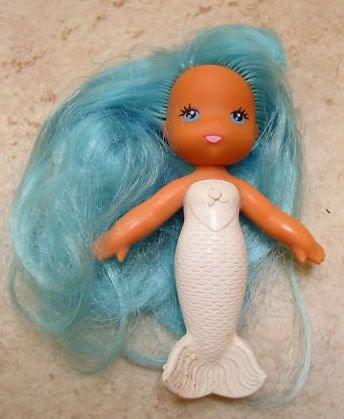
Kenner See Wees & Shimmers
With the '80's, we are now entering into the truly modern era (as opposed to vintage) - and also into the time of dolls which - alas!! - I am just a tiny bit too old to remember personally from my own childhood, though I was still young enough at this point to remember the commercials for these during Saturday morning cartoons, and be at least a little bit interested.
See Wees, manufactured by Kenner, were officially debuted in 1979. However, their candy colors and style of painting are very quintessentially 1980's in style.
First came the See Wee mermaids, with combs for their rooted nylon hair. They were next produced with small "babies" which were entirely molded. They came in shells with sponges. They were intended for the bathtub.
The next phase saw the production of so-called "Shimmers," which had the distinction of being painted with shimmery colors in place of the flat colors of the Sea Wees. This category had mom-and-baby combos of mermaids, but also centaurs, butterflies, deer and bird hybrids. All came with their own combs.
These are quite collectible, and are going for a respectable price in the collectible doll market.
See Wees, manufactured by Kenner, were officially debuted in 1979. However, their candy colors and style of painting are very quintessentially 1980's in style.
First came the See Wee mermaids, with combs for their rooted nylon hair. They were next produced with small "babies" which were entirely molded. They came in shells with sponges. They were intended for the bathtub.
The next phase saw the production of so-called "Shimmers," which had the distinction of being painted with shimmery colors in place of the flat colors of the Sea Wees. This category had mom-and-baby combos of mermaids, but also centaurs, butterflies, deer and bird hybrids. All came with their own combs.
These are quite collectible, and are going for a respectable price in the collectible doll market.
Polly Pocket
These tiny modern versions of the ancient "peg"-type of doll were released in 1989, though invented in 1983 by an Englishman; they were first brought out by Bluebird in 1989 in England. These were produced through 1992 or 1993; they were very much a late-'80's kind of concept, as they were bought out by their distributors Mattel in 1993. That was a turning-point for Polly, who thereafter was totally revamped; the concept of the doll changed considerably from the original versions.
The originals are now highly collectible; they were produced in large numbers though but for a limited time.
These peg-dolls are hinged in their middles; they are only slightly more than 1" high. They have tiny round bases which peg into the indentations and rings in the compacts that are meant to hold them. One can position them in many different places in the compacts.
They have many tiny accessories, etc. that also peg in place. There were Polly necklaces, palaces, houses, workplaces - just about anything you can imagine!
My own little examples light up. (Yes, they still work! ;) ) The one pictured is the heart-shaped Princess' palace, with her Prince Charming, `a laCinderella . The other I have is a star-shaped one, rather larger, which contains a tiny party palace, with a working Ferris wheel in the "grounds" in front.
I'm not much of a fan, personally, of pegs, or of the new idea of snap-on-snap-off plastic clothes, which one can find with the modern Pollys and also with certain of the smallest Bratz; I like real hair and clothes, myself. But the winning combination of diminutive scale plus lighting won me over in the case of my two. (Off to eBay to find MORE light-up ones... XD )
These tiny modern versions of the ancient "peg"-type of doll were released in 1989, though invented in 1983 by an Englishman; they were first brought out by Bluebird in 1989 in England. These were produced through 1992 or 1993; they were very much a late-'80's kind of concept, as they were bought out by their distributors Mattel in 1993. That was a turning-point for Polly, who thereafter was totally revamped; the concept of the doll changed considerably from the original versions.
The originals are now highly collectible; they were produced in large numbers though but for a limited time.
These peg-dolls are hinged in their middles; they are only slightly more than 1" high. They have tiny round bases which peg into the indentations and rings in the compacts that are meant to hold them. One can position them in many different places in the compacts.
They have many tiny accessories, etc. that also peg in place. There were Polly necklaces, palaces, houses, workplaces - just about anything you can imagine!
My own little examples light up. (Yes, they still work! ;) ) The one pictured is the heart-shaped Princess' palace, with her Prince Charming, `a la
I'm not much of a fan, personally, of pegs, or of the new idea of snap-on-snap-off plastic clothes, which one can find with the modern Pollys and also with certain of the smallest Bratz; I like real hair and clothes, myself. But the winning combination of diminutive scale plus lighting won me over in the case of my two. (Off to eBay to find MORE light-up ones... XD )
1971-1980
 Dawn is one of my fondest childhood memories - even the only two actual "Dawn" Dawns I ever owned managed to be identically factory-defective - both snapped apart at the waist when I tried to rotate them! :(
Dawn is one of my fondest childhood memories - even the only two actual "Dawn" Dawns I ever owned managed to be identically factory-defective - both snapped apart at the waist when I tried to rotate them! :(The one I managed to preserve from childhood was that then rarity, an African American model whose name was Dale.
These diminutive fashion dolls (at 6", among the smallest modern fashions to be found) were manufactured by a small operation called Topper Toys in 1970. They went bankrupt in 1973; but in that short time, they managed to produce a big collection of these small fashions.
Dale, Angie and Dawn herself were the first dolls. Then came other "friends;" these were presented as models living the "high life."
The Modeling Agency dolls came out later; there were six of these.
They had a huge collection of fashions, from complete everyday outfits through elaborate evening ensembles. There were a couple of wedding ensembles produced as well, one of which is of considerable rarity now.
The fashions all had fun names, such as "Pink Slink," "Furry Flounce" and "Mad About Plaid."
They also had boyfriends (and potential grooms) who went by the names of Gary, Kevin and Van, a very rare early African-American male fashion. (I find him interesting in particular due to his very ethnic appearance, which sets him apart from dolls whose head-molds are the same as the Caucasian males - which give them the appearance of Caucasians in "black-face," so to speak, rather than the appearance of a genuinely ethnic type.)
My Dale is still with me (I found her to be the coolest of the collection at seven years old!); she suffers from non-bending leg syndrome, but is otherwise in very spiffy condition.
These dolls also, unfortunately, suffer from that malady, copper gangrene. Again, a packaged example is not a guarantee against this, since moisture gets in depending upon how and where the dolls have been stored. (The ethnic dolls have less of this problem due to the dark shade of the vinyl.) The spotless examples are the most highly-coveted doll specimens to the collectors, once again.
Also as in the case of Kiddles, there were many accessories and peripheral paraphernalia to be had; there was a beauty parlor, an elaborate fashion-show theater complete with moving catwalk mechanism, a penthouse, furniture, various props (such as her tiny white poodle) and clothes, clothes, clothes.
I now have a pretty complete collection of the dolls I always wanted so badly as a child. They are all now waiting to be installed in their permanent display, a large white shadow-box which I have lined the back of with a vintage '70's hot-pink-and-gold-glitter paisley chiffon fabric (the box and fabric are both white in background color). The only thing holding up the project as of now is the lack of a single pair of tiny gold shoes for my Jessica, whose golden ensemble, named "Glimmer Glamor," is missing this single item. Frustrating! ;)
Subscribe to:
Posts (Atom)
